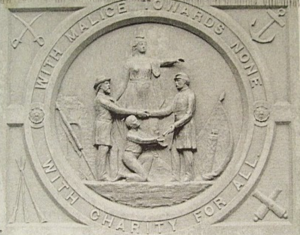Historic monuments and markers are in the news for the stories they tell, the people they memorialize, and for the stories left untold. This inquiry uses St. Gaudens’ Shaw Memorial to introduce students to visual thinking and symbolism. It then asks them to analyze the Soldiers’ Monument in Brattleboro and consider the perspectives of those depicted. Finally, students are asked to find and review the markers in their own communities, taking action if they feel it is needed. The power of monuments on our landscape and in our communities continues to be strong and occasionally can lead to violence such as what we saw in Charlottesville, VA, in 2017.
Grade Level: Middle-High School
Topics: Monuments & Memorials, Civil War
Enduring Understanding:
Systemic racism is a foundation of American society. Throughout history Black Vermonters have faced bias and discrimination, and this is still true today.
Compelling Question: Who decides which stories are being told?
Historical Thinking Skills: Historical Empathy, Multiple Perspectives
Background Knowledge
As a class, use this guided worksheet to investigate the Shaw Memorial by St. Gaudens (whose studio is nearby in Cornish, NH). Discuss the message of the monument and whose perspective(s) are shown. Why do we have monuments? In summer 2020 the Shaw Memorial was defaced. Ask students how those who defaced the monument might have made a different choice if they had analyzed the memorial more deeply.
A preface to the monument investigation might include a discussion about the removal of monuments. Potential sources:
The question of renaming Jacobs Street in Windsor which includes an audio story
Painting over the Vermont Law School Underground Railroad mural
A black artist statement about how making changes mutes her work
Analyzing Primary Sources
Examine this Brattleboro Soldiers’ monument using this multiple viewpoints activity.
Read this article about the monument. What does the class think? Should the monument be modified? Why?
Historical Research
Assignment: Have students find a monument, memorial, or historic marker in their community. Photograph the marker, summarize the information, identify whose story is being told. If students can’t search on foot, here is a complete list of Vermont’s historic makers; here is the list for New Hampshire.
Use the multiple viewpoints activity to further highlight the stories that are told or are left untold.
Discussion
Whose stories are being told in our community? Are they stories of war? peace? heroes? women? people of color? inventions?
People have different ideas about what is most important in a marker or memorial. What do you think is most important? Who gets to decide?
Should historic markers or monuments ever be moved or removed? Why?
Summative Assessment
Take action! Whose voices or stories are missing from the markers in your community? Write a persuasive essay proposing a marker or other public program to your local historical society that amplifies a story.
Primary Sources and Worksheets Used in the Lesson
Background information on the Shaw Memorial
Shaw Memorial Guided Looking Worksheet
Brattleboro Reformer Newspaper Article
List of Vermont Historic Markers and link to propose a new one
List of New Hampshire Historic Markers and link to propose a new one
Additional Resources
Ellen Fisher, 7th grade teacher at Richmond Middle School in Hanover, created a monument lesson you can see here.
